Dadasaheb Phalke Award facts for kids
Quick facts for kids Dadasaheb Phalke Award |
|
|---|---|
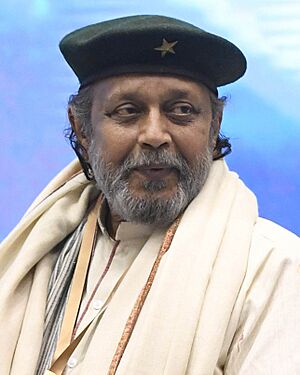
The 2022 recipient: Mithun Chakraborty
|
|
| Reward |
|
| Currently held by | Mithun Chakraborty |

The Dadasaheb Phalke Award is the highest honor in Indian cinema. The Government of India gives this award every year at the National Film Awards. It celebrates people who have made amazing contributions to Indian movies. A special group of important people from the film industry chooses the winner. The award includes a Golden Lotus medal, a shawl, and a cash prize of 1,000,000 Indian Rupees.
This award started in 1969 to remember Dadasaheb Phalke. He was a famous Indian filmmaker (1870–1944). Many people call him "the father of Indian cinema." He directed India's very first full-length movie, Raja Harishchandra, in 1913.
The first person to receive the award was actress Devika Rani in 1969. As of 2025, 54 people have received this award. Only two people, Prithviraj Kapoor (1971) and Vinod Khanna (2017), received it after they had passed away. Prithviraj Kapoor's son, Raj Kapoor, accepted the award for him. Raj Kapoor also received the award himself in 1987.
Some families have multiple winners. For example, brothers B. N. Reddy (1974) and B. Nagi Reddy (1986) both won. Also, brothers Raj Kapoor (1987) and Shashi Kapoor (2014) received it. Sisters Lata Mangeshkar (1989) and Asha Bhosle (2000) were also honored. Filmmaker brothers B. R. Chopra (1998) and Yash Chopra (2001) also won. The most recent winner is the famous actor Mithun Chakraborty, who received the award in 2024 for his contributions in 2022.
Award Winners: A Look at Their Contributions
This section lists some of the amazing people who have won the Dadasaheb Phalke Award. Each person made a big difference in Indian cinema.
| Year (Ceremony) |
Image | Recipient | Film industry | Notes |
|---|---|---|---|---|
| 1969 (17th NFA) |
 |
Devika Rani | Hindi | Known as "the first lady of Indian cinema". She started in Karma (1933), India's first English-language film. She also started Bombay Talkies, a film company, in 1934. |
| 1970 (18th NFA ) |
 |
Birendranath Sircar | Bengali | He founded two production companies, International Filmcraft and New Theatres. He is seen as a pioneer of Indian cinema. |
| 1971 (19th NFA) |
 |
Prithviraj Kapoor | Hindi | He acted in India's first sound film, Alam Ara (1931). He also founded Prithvi Theatre, a traveling theater company. |
| 1972 (20th NFA) |
 |
Pankaj Mullick | • Bengali • Hindi |
A composer, singer, and actor. He is famous for Mahishasuramardini, a radio musical from 1931. |
| 1973 (21st NFA) |
 |
Ruby Myers (Sulochana) | Hindi | One of the highest-paid actresses of her time. She started in Veer Bala (1925). |
| 1974 (22nd NFA) |
 |
B. N. Reddy | Telugu | He directed fifteen Telugu films. He was the first Indian film person to get a Doctor of Letters degree. |
| 1975 (23rd NFA) |
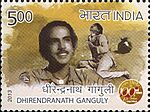 |
Dhirendra Nath Ganguly | Bengali | He helped start the Bengali film industry. He also started three production companies. |
| 1976 (24th NFA) |
 |
Kanan Devi | Bengali | Called "the first lady of Bengali cinema". She acted in silent films in the 1920s. She was also a producer. |
| 1977 (25th NFA) |
 |
Nitin Bose | • Bengali • Hindi |
A cinematographer, director, and screenwriter. He introduced playback singing to Indian cinema in 1935. |
| 1978 (26th NFA) |
 |
Raichand Boral | • Bengali • Hindi |
A pioneer of Indian film music. He helped introduce playback singing with Nitin Bose. |
| 1979 (27th NFA) |
 |
Sohrab Modi | Hindi | An actor and filmmaker. He brought Shakespearean stories to Indian cinema. |
| 1980 (28th NFA) |
Paidi Jairaj | Hindi | An actor and director known for playing historical characters. He helped start the Filmfare Awards. | |
| 1981 (29th NFA) |
 |
Naushad | Hindi | Music director who started with Prem Nagar (1940). He introduced sound mixing to Indian cinema. |
| 1982 (30th NFA) |
 |
L. V. Prasad | • Telugu • Tamil • Hindi |
He acted in the first talkie films in three languages. He founded Prasad Studios, which made over 150 films. |
| 1983 (31th NFA) |
 |
Durga Khote | • Hindi • Marathi |
A pioneer among women in Indian cinema. She started two production companies. |
| 1984 (32nd NFA) |
 |
Satyajit Ray | Bengali | His first film was Pather Panchali (1955). He brought Indian cinema worldwide recognition. |
| 1985 (33rd NFA) |
 |
V. Shantaram | • Hindi • Marathi |
He produced and directed India's first color film, Sairandhri (1931). He worked on nearly 100 films. |
| 1986 (34th NFA) |
 |
B. Nagi Reddy | Telugu | He produced over 50 films. He built Vijaya Vauhini Studios, one of Asia's biggest film studios. |
| 1987 (35th NFA) |
 |
Raj Kapoor | Hindi | Often called "The Show Man". His performance in Awara (1951) was ranked among the top ten greatest performances by Time magazine. |
| 1988 (36th NFA) |
 |
Ashok Kumar | Hindi | Known as "Dadamoni". He starred in Kismet (1943), which was a huge hit in Indian cinema. |
| 1989 (37th NFA) |
 |
Lata Mangeshkar | • Hindi • Marathi |
Called the "Nightingale of India". She started singing in 1942 and has sung in over 36 languages. |
| 1990 (38th NFA) |
 |
Akkineni Nageswara Rao | Telugu | He acted in over 250 films, mostly in Telugu. He started in Dharma Patni (1941). |
| 1991 (39th NFA) |
 |
Bhalji Pendharkar | Marathi | A filmmaker who started in the 1920s. He made over 60 Marathi films and 8 Hindi films. |
| 1992 (40th NFA) |
 |
Bhupen Hazarika | Assamese | Known as "the Bard of Brahmaputra". He is famous for his folk songs in the Assamese language. |
| 1993 (41st NFA) |
 |
Majrooh Sultanpuri | Hindi | A lyricist who wrote about 8000 songs for over 350 Hindi films. |
| 1994 (42nd NFA) |
 |
Dilip Kumar | Hindi | Called the "Tragedy King". He acted in over 60 Hindi films for more than six decades. |
| 1995 (43rd NFA) |
 |
Rajkumar | Kannada | He acted in over 200 Kannada films. He also won a National Film Award for Best Male Playback Singer. |
| 1996 (44th NFA) |
 |
Sivaji Ganesan | Tamil | He appeared in over 300 films. He was the first Indian actor to win a "Best Actor" award at an international film festival. |
| 1997 (45th NFA) |
 |
Kavi Pradeep | Hindi | Best known for the patriotic song "Aye Mere Watan Ke Logo". He wrote about 1700 songs. |
| 1998 (46th NFA) |
 |
B. R. Chopra | Hindi | He started his own production house, B. R. Films. He is known for films like Naya Daur and the TV series Mahabharat. |
| 1999 (47th NFA) |
 |
Hrishikesh Mukherjee | Hindi | He directed 45 Hindi films. He made "middle-of-the-road cinema" popular with films like Anand. |
| 2000 (48th NFA) |
 |
Asha Bhosle | • Hindi • Marathi |
A playback singer with "extraordinary range". She began her singing career in 1943. |
| 2001 (49th NFA) |
 |
Yash Chopra | Hindi | The founder of Yash Raj Films. He directed 22 Hindi films. |
| 2002 (50th NFA) |
 |
Dev Anand | Hindi | Called "evergreen star of Hindi cinema". He co-founded Navketan Films and produced 35 films. |
| 2003 (51st NFA) |
 |
Mrinal Sen | • Bengali • Hindi |
One of "India's most important filmmakers". He made 27 films in 50 years. |
| 2004 (52nd NFA) |
 |
Adoor Gopalakrishnan | Malayalam | He started the new wave cinema movement in Malayalam. He is praised for showing complex problems simply. |
| 2005 (53rd NFA) |
 |
Shyam Benegal | Hindi | He started by making advertising films. His films often focus on women and their rights. |
| 2006 (54th NFA) |
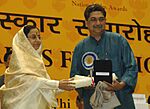 |
Tapan Sinha | • Bengali • Hindi |
He made over 40 feature films. Many of his films talked about problems faced by ordinary people. |
| 2007 (55th NFA) |
 |
Manna Dey | • Bengali • Hindi |
He sang over 3500 songs in many Indian languages. He mixed Indian classical music with pop. |
| 2008 (56th NFA) |
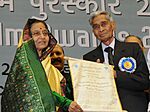 |
V. K. Murthy | Hindi | A cinematographer known for working with director Guru Dutt. He shot India's first cinemascope film, Kaagaz Ke Phool (1959). |
| 2009 (57th NFA) |
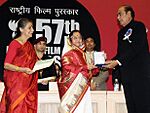 |
D. Ramanaidu | Telugu | He produced over 130 films in many Indian languages. He is in The Guinness Book of World Records for producing films in nine languages. |
| 2010 (58th NFA) |
 |
K. Balachander | Tamil | He directed and produced over 100 films. He founded Kavithalayaa Productions. |
| 2011 (59th NFA) |
 |
Soumitra Chatterjee | Bengali | Known for working often with director Satyajit Ray. He was the first Indian film person to receive France's highest award for artists. |
| 2012 (60th NFA) |
 |
Pran | Hindi | An actor known for playing villain roles in Hindi films for over 50 years. |
| 2013 (61st NFA) |
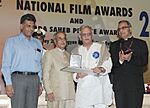 |
Gulzar | Hindi | A lyricist, director, and poet. He wrote his first Hindi song in 1963 and won many awards for his lyrics. |
| 2014 (62nd NFA) |
 |
Shashi Kapoor | Hindi | He started as a child actor. He played a big role in bringing back the Prithvi Theatre group. |
| 2015 (63rd NFA) |
 |
Manoj Kumar | Hindi | Known as the patriotic hero, he is fondly called "Bharat Kumar". He acted and directed movies with patriotic themes. |
| 2016 (64th NFA) |
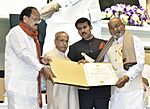 |
K. Viswanath | Telugu | He started as a sound recordist. He directed 53 feature films and received international recognition. |
| 2017 (65th NFA) |
 |
Vinod Khanna | Hindi | An actor known for his work in Hindi films during the 1970s. He also entered politics later. |
| 2018 (66th NFA) |
 |
Amitabh Bachchan | Hindi | Often called the Shahenshah of Bollywood. He has appeared in over 200 Indian films. He is one of the greatest actors in Indian cinema history. |
| 2019 (67th NFA) |
 |
Rajinikanth | Tamil | An Indian actor known as superstar in Tamil cinema. He has also worked as a producer and screenwriter. |
| 2020 (68th NFA) |
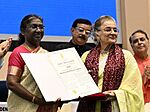 |
Asha Parekh | Hindi | She started as a child artist in Maa (1952). She is called Jubilee Girl in Hindi cinema. She also directed TV series. |
| 2021 (69th NFA) |
 |
Waheeda Rehman | Hindi | She debuted in the Telugu film Rojulu Marayi (1955). She starred in many famous films like Guide (1965) and Rang De Basanti (2006). |
| 2022 (70th NFA) |
 |
Mithun Chakraborty | • Bengali • Hindi |
He started his film career in 1976 with Mrigayaa. His popularity grew with Disco Dancer. He has won many awards and worked in different languages and on TV. |
| Dadasaheb Phalke Award | |
|---|---|

A commemorative postage stamp on DADASAHEB PHALKE 1870-1944.
|
|
| Type | Commemorative |
| Country of issue | India |
| Date of issue | 30 Apr 1971 |
| Face value | 20 nP |
Other Awards with Similar Names
You might hear about other awards or film festivals that also use the name Dadasaheb Phalke. These include the Dadasaheb Phalke International Film Festival or Dadasaheb Phalke Excellence Awards. It's important to know that these awards are not the same as the official Dadasaheb Phalke Award given by the Government of India.
Some famous filmmakers, like Shyam Benegal, have suggested that the government should stop others from using the name. However, the government's Information and Broadcasting ministry has said they cannot do this. This is because the names of these new awards are not exactly the same as the official one.
See also
 In Spanish: Premio Dadasaheb Phalke para niños
In Spanish: Premio Dadasaheb Phalke para niños

